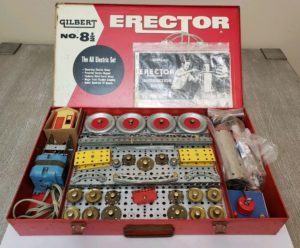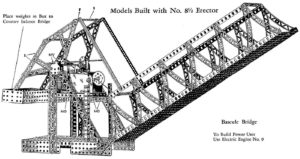
Late in the year 1969, I got a Gilbert erector set. I even know the model that it was, but not from memory. Gilbert, who by then had been purchased by the Gabriel Co., only had a few different sets on the market.
I had a Senior Powerline set. It had a battery-powered motor so you could make amazing creations like rotating ferris wheels, a lift drawbridge, a crane, and many more acts of engineering.
The concept of the erector set sprang into the mind of A.C. Gilbert as he watched a skyscraper being built in 1911. He pictured a simple toy, a collection of miniature girders, beams, wheels, gears, and metal plates, all designed to be held together with small nuts and bolts.
Gilbert had the money to create and produce the toy, and also launched a national advertising campaign in 1913. Interestingly, that decade would also see the introduction of two other construction toys, Lincoln Logs and Tinkertoys.
The erector set was a wonderfully heavy gift for a child to unwrap. It was full of real metal parts, and you knew that this toy would last considerably longer than your plastic ones.
And what you built was up to you! The bigger projects took more time and work, so if your time was limited, you might make something small. The included manual contained a massive collection of projects running the gamut form the simple to the complex.
However, one thing I could not do was freelance.

If I tried to make something up out of my imagination, it would never work. I would end with a collection of metal parts bolted together that looked like a random collection of metal parts bolted together. I guess that proves I don’t have the mind of an architect or engineer. I was certainly never tempted to pursue either career path.
However, when I followed the plans, I was capable of making extraordinary creations. I beamed with pride as I would carry in things like wreckers, windmills, and hoists and show them to my parents. I don’t know if they were really impressed or not, but they sure made me think so.
An erector set taught a kid the importance of committing to a cause. It might take hours to make something really big and elaborate. It wasn’t like playing with your other toys. Commencing to build a motor-powered crane didn’t allow walking away from the project before completion, at least not if your mom insisted on you keeping your room clean and picked up. So you stuck with it until it was finished.
Ah, but the reward! When you’re ten years old, and frustrated because your artistic endeavors look like they were created by a ten-year-old, it filled you with pride to look at your erector set creation that looked just like the plans!
The nature of a toy consisting of lots of little parts meant that some of them would inevitably get lost. And when enough parts vanished, the set itself became a lot less fun to play with. So eventually, it would be discarded.
But the memories live on forever of how satisfying it was to build impressive structures. And so does the idea of making a solid commitment to a cause that requires time and effort to see through to completion.